
MAY CONTAIN NUTS

Search Shorpy
SHORPY ART

Framed or unframed, desk size to sofa size, printed by us in Arizona and Alabama since 2007. Explore now.
Join and Share
Ad-Free Shorpy
Shorpy is funded by you. Patreon contributors get an ad-free experience.
Learn more.

Recent comments
- Baldwin 62303
- Baldwin VO-1000
- Cold
- No expense spared
- Tough Guys
- Lost in Toyland
- And without gloves
- If I were a blindfolded time traveler
- Smoke Consumer Also Cooks
- Oh that stove!
- Possibly still there?
- What?!?
- $100 Reward
- Freeze Frame
- Texas Flyer wanted
- Just a Year Too Soon
- WWII -- Replacing men with women at the railroad crossing.
- Yes, Icing
- You kids drive me nuts!
- NOT An Easy Job
- I wonder
- Just add window boxes
- Icing Platform?
- Indiana Harbor Belt abides
- Freezing haze
- Corrections (for those who care)
- C&NW at Nelson
- Fallen Flags
- A dangerous job made worse
- Water Stop
Member Photos
The Shorpy
Print Emporium
Print Emporium
Search Shorpy
Search results -- 30 results per page
- Astoria, Oregon: 1944
- "Astoria '44" is the latest Kodachrome from Navy photographer's mate Don Cox. ... pavement very photogenic Don was fortunate to find Astoria when it had been raining. It's a rare occurrence in that arid corner of ... Battery Russell maybe? Or even Tongue Point. With the war, Astoria was probably about the size it is today. Little over 10,000 people.
... Posted by Dave - 03/24/2021 - 10:54am -
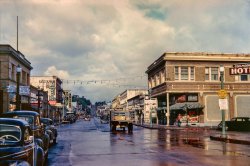
- Astoria Houses: 1951
- Sept. 22, 1951. "New York City Housing Authority. Astoria Houses, Queens. Exterior, East River park with children. Clarke, ... to the NYC Housing Authority which owns and maintains the Astoria Houses the site has 22 Buildings, 1102 Apartments and 3,135 residents. ... Posted by Dave - 12/01/2015 - 10:46pm -
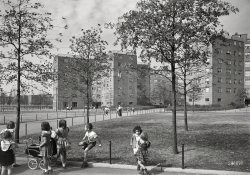
- Hell Gate: 1930s
- ... Bridge across the East River in the distance, the Waldorf-Astoria towers and 230 Park Avenue (Helmsley Building) foreground, Lincoln ... nitrate negative by Arnold Genthe. View full size.
Astoria, Queens I was a kid in Astoria in the 40's. To the right of the ... Posted by Dave - 09/25/2013 - 2:16pm -
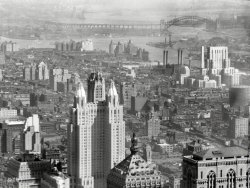
- Big Gun: 1917
- ... know about.
There is a similar fort (Ft. Stevens) near Astoria, Oregon, that had the same type of guns. Fort Stevens was shelled by a ... Posted by Dave - 02/26/2024 - 11:02pm -
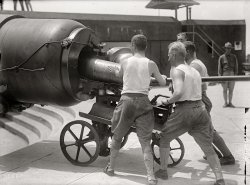
- Phipps Garden: 1940
- ... has been around for centuries. -tterrace]
Sunnyside/Astoria/Long Island City Phipps is in zip 11104; the post office's preferred designation is Sunnyside, but Long Island City and Astoria are also acceptable for parts of the zip. For a while in college I was ... Posted by Dave - 05/10/2014 - 10:04am -
![Phipps Garden: 1940 May 17, 1940. "Phipps Garden Apartments, 5101 39th Avenue, Long Island City, New York. Clarence S. Stein, architect." Hanging with a big girl whose feet touch the ground. Large-format negative by Gottscho-Schleisner. View full size.
An early housing experimentPhipps Gardens is still a desirable development after all these years. It's owned and managed by a nonprofit corporation, with apartments made available at affordable rents to people who meet income guidelines. The concept is similar to the neighboring and larger Sunnyside Gardens, though the latter development is a cooperative rather than rentals. Both developments were inspired by the English "Garden City" movement and built by a corporation headed by various dignitaries including Eleanor Roosevelt. The idea was that providing working-class people with (relatively) low density housing that included ample open space would cure many of the social ills associated with tenement life. Whether or not that experiment succeeded or not is hard to say, but given that the developments remain quite nice today a qualified "yes" may be in order.
The photo's caption notwithstanding, Phipps Garden is not in Long Island City. As the name of its neighbor Sunnyside Gardens suggests, it's in the Sunnyside neighborhood. While Long Island City has gotten a bigger influx of affluent people who work in Manhattan, Sunnyside is a desirable neighborhood itself with its tree-lined streets and a bit of a small town feel. In the 1940's and 1950's it was known as New York's nursery on account of the high birthrate among the young families living in the area.
Current view of Phipps Garden:
View Larger Map
BenefactorHenry Phipps (1839-1930) grew up poor in a Pittsburgh tenement and became a friend of a neighbor, the Scottish immigrant, Andrew Carnegie. He worked for Carnegie as a bookkeeper. Carnegie Steel was merged with the steel companies controlled by another Robber Baron, Henry Clay Frick in 1901. Phipps part of the deal earned him $69.5 million, worth today, just slightly south of 2 Billion. His family Bank, the Bessemer Trust, controlled now by his Great Grandson, Stuart S. Janney III, was able to increase the net worth many times. Phipps became a Philanthropist building affordable housing for NYC Working People. Thousand of housing units have been built over those years, including those in today's Blog. Attached is a shot of Henry Phipps Plaza in the Kips Bay Section of Manhattan.
HeyHula Hoops weren't invented till the 60's, what is that?
[Wham-O's hula hoop dates from 1958, but hoop rolling has been around for centuries. -tterrace]
Sunnyside/Astoria/Long Island CityPhipps is in zip 11104; the post office's preferred designation is Sunnyside, but Long Island City and Astoria are also acceptable for parts of the zip. For a while in college I was a Fuller Brush salesman in this general area. Lots of 4-6 story walkups. I didn't last too long.
(The Gallery, Gottscho-Schleisner, Kids, NYC)](https://www.shorpy.com/files/images/SHORPY-5a05074u.thumbnail.jpg)
- Death Star: 1902
- Circa 1902. "The Waldorf-Astoria, New York." The original, and somewhat forbidding, Waldorf at Fifth ... of open windows.
It Hyphened One Night The Waldorf-Astoria was originally built as 2 separate hotels by feuding members of the ... (the shorter half) was built in 1983 1883, and the Astoria on the right was completed in 1897. The two were soon operated as one ... Posted by Dave - 06/25/2023 - 12:40pm -
![Death Star: 1902 Circa 1902. "The Waldorf-Astoria, New York." The original, and somewhat forbidding, Waldorf at Fifth Avenue and 34th Street. Complete with the obligatory windowsill milk bottle. 8x10 inch dry plate glass negative, Detroit Photographic Company. View full size.
OK - I give up.What's an "obligatory windowsill milk bottle?"
[A familiar sight on these pages. Left out to chill. - Dave]
It stood for less than 40 yearsTorn down in 1929 to make way for the Empire State Building.
The storks also deliver milk!It's amazing that, in addition to tiny babes, the storks are also adept at delivering windowsill milk bottles.... 7 stories high!
34th StreetThe street on the north side, the one with the trolley, appears narrower than it is today. It may be an optical illusion but it seems to be missing a lane on both sides. Today 34th Street is one of the busiest in the city, leading east to the Queens-Midtown Tunnel and Long Island and west to the world's largest store, Macy's, and continuing to the Lincoln Tunnel to New Jersey and points beyond. This of course, takes nothing away from the magnificent old Waldorf or its successor, the landmarked Empire State Building.
Police HatAlways a little tip-off on the season to check the hats of the cops. The gray ones were worn in summer, blue in Winter. Likewise with the straw hats. There was a season for them, much like we used to say about white pants. There was the famous "straw hat riot" in 1922 where a bunch of street toughs started ripping the skimmers off men who'd worn them after the agreed-upon cut-off date.
[Probably the best seasonal tipoff: Windowsill milk bottles! - Dave]
v = ?(2gx)Given the generous "no walk" zones at sidewalk level, do you
suppose the engineers took the milk bottle "Oops Factor" into
consideration?
Movie SetLooks like Sigourney Weaver's apartment building in "Ghostbusters."
[Which was on Central Park West. - Dave]
It may be cold outside but it's sure hot in here!I guess the steam heat was cranking because there are an awful lot of open windows.
It Hyphened One NightThe Waldorf-Astoria was originally built as 2 separate hotels by feuding members of the Astor family. The Waldorf on the left (the shorter half) was built in 1983 1883, and the Astoria on the right was completed in 1897. The two were soon operated as one hotel, but it's apparently possible to separate them back into two distinct entities if needed.
One assumes that ..you could get a Waldorf Salad here. And screwdrivers.
The Waldorf SaladIt seems like Doghouse Riley has been watching too many Fawlty Tower reruns, as well as myself. The Waldorf Salad episode is one of my favorites.
Astor CourtThe banner on top of the short building on the right probably reads "Astor Court" - not "Astoria." The Astor Court Building stood just west of the private alley (also called Astor Court) that separated it from the Waldorf-Astoria Hotel. All of this became part of the site of the Empire State Building.
Tricks of the House WreckersModern Mechanics featured the demolition of the Waldorf Astoria in the June 1930 issue. Click to enlarge.
Penthouse ViewsWhat would the uses of the top several floors be in this building? They are very unusual; the arrangement, size and shape of the top floor windows.
Actuallythe name was the Waldorf=Astoria! The "=" sign was put in because the cousins who built the two side by side hotel couldn't agree on whose name would be first in the new name!
I would have loved to have stayed here, even in the smallest room.
The old family homesteadAccording to an old family legend, an ancestor of mine once had his farm at this location in the early 19th century. I'm sure he'd kick himself If he could see what the property values were now!
What a beauty!I'd like to live there those times and see it with my own eyes!
Maitre d' MarcosMy grandfather Marcel Burgos was maitre d' for this Waldorf for many years during the 1920s. My dad told many stories about him. Anybody out there have any records of any employes from there?
(The Gallery, DPC, NYC, Streetcars)](https://www.shorpy.com/files/images/4a09397a.thumbnail.jpg)
- The Waldorf-Astoria: 1910
- New York circa 1910. "Waldorf-Astoria Hotel, Fifth Avenue and West 34th Street." Note the radio masts on ... on Fifth Avenue at 33rd St. John Jacob Astor IV opened the Astoria Hotel in 1897 on the southwest corner of Fifth Avenue and 34th St. After legal maneuvering, they merged as the Waldorf-Astoria, with 13 entrances. What we're seeing in the Shorpy photo is mainly the ... Posted by Dave - 03/20/2023 - 9:25pm -
![The Waldorf-Astoria: 1910 New York circa 1910. "Waldorf-Astoria Hotel, Fifth Avenue and West 34th Street." Note the radio masts on the roof; the 12 wires strung between the towers, 236 feet apart, are too faint to be seen. 8x10 inch dry plate glass negative, Detroit Publishing Company. View full size.
Don't Fall!So either that is a facility manager and a midget, or a policeman talking down a jumper. Either way. a precipitous precarious situation.
Future site of ...... the Empire State Building.
The story behind the hyphenIt was originally two hotels on the same block, built by feuding cousins. The Waldorf Hotel, developed by William Waldorf Astor, opened in 1893 on Fifth Avenue at 33rd St. John Jacob Astor IV opened the Astoria Hotel in 1897 on the southwest corner of Fifth Avenue and 34th St. After legal maneuvering, they merged as the Waldorf-Astoria, with 13 entrances. What we're seeing in the Shorpy photo is mainly the Astoria part.
The whole thing was razed in 1929 to make way for the Empire State Building. Today's Waldorf Astoria (no hyphen), on Park Avenue, opened in 1931.
Hide & Seek With the Missing LinesBy adjusting the contrast, saturation, gamma, etc., we can find the missing lines!
Wireless TowersThe New York Sun -- March 06, 1909, Page 12:
"Two forty foot steel towers with wooden staves twenty two additional feet high to be erected above the big pent house on the roof of the Waldorf-Astoria"
Floorplans and descriptionAll this is from the February 5, 1898, issue of Architecture and Building magazine. There is a descriptive narrative that covers everything from the giant battery in the sub-basement to the grand promenade on the roof.
The article also included floorplans for the
ground floor,
first floor,
fourth floor, and the
roof garden.
In the fourth-floor floorplan notice the extra thick wall that runs lengthwise across the middle of the floorplan. That's where the Astoria Hotel (bottom) was joined to the existing Waldorf Hotel (top). Once you see where that is, you can easily see it on the ground and first floor plans.
PhotosI've learned not to try to load too many photos in a single submission. Here are the photos that were part of the February 5, 1898, issue of Architecture and Building magazine:
Writing room,
Astor gallery,
Main restaurant,
Grand Ballroom,
Garden Court of Palms,
Royal suite reception room, and
Royal suite bedroom.
This last photo is from a June 1904 issue of The Architectural Record magazine. I believe it is the West Foyer on the first floor.
There's a naked lady in one of those windows --Or probably should be.
I'm out on the ledge but ...we aren't jumpers, we are doing a little repair work. By the way, the ledge is wide enough to do a ballet.
The antennaThe antenna wires must be more like 150 ft long, if they're parallel to Fifth Avenue. The block is 197-1/2 ft long.
[They're parallel to 34th Street, where the building's frontage is 350 feet. - Dave]
(Technology, The Gallery, DPC, NYC, Streetcars)](https://www.shorpy.com/files/images/SHORPY-4a19951a.thumbnail.jpg)
- A&P: 1949
- ... such cruel irony. This location is actually in the town of Astoria, which is in the county of Queens and is still a great place to get Italian Ice.
[Actually, Astoria is a neighborhood in the borough of Queens. -Dave]
View ... Posted by Dave - 02/06/2015 - 11:14pm -
![A&P: 1949 New York, 1949. "A&P Supermarket on Broadway in Queens." Now playing at the Strand: Alan Ladd in Whispering Smith. Photo by John M. Fox. View full size.
Baby BoomersThe occupants of those buggies are retired now.
The difference that 66 years makeHere is the same street, Broadway, today. The A&P is now Lanzee Department Store. The store at 25-37 Broadway was the Strand Bakery and is now a Dentist, such cruel irony. This location is actually in the town of Astoria, which is in the county of Queens and is still a great place to get Italian Ice.
[Actually, Astoria is a neighborhood in the borough of Queens. -Dave]
View Larger Map
By the hydrantI wonder what's going on here with the woman and the two boys? What is she standing on?
[The sidewalk. The thing in front of her is a little shovel. - Dave]
Buggy!One of those words from the so distant past!
8 Years OldThe Strand was opened on August 27 1941 with its first showing being The Wild Man of Borneo.
8 O'Clock at A&PIn my early childhood, we would take my grandmother grocery-shopping (she didn't drive) to the A&P. I remember the delightful smell of standing by the 8 O'Clock grinder as Grandma got her coffee. And here I sit, 60+ years later, sipping a mug of 8 O'Clock.
Well Madge,you just really don't know when you will run out of Crisco.
I Know This Block Very WellGrew up in Astoria in the 1950's (and still live here 50 years later). The Strand Theatre & Bowling Alley (the latter was in the basement) lasted through the 1970's. The A & P Self-Serve Supermarket became a Key Food store (after A-&-P relocated down the block just off Crescent Street) - G.T. Lawe's variety store expanded into some of the smaller shops and also continued in business through the 1970's, as did the Strand bakery at the 29th Street corner. Today this block remains a vibrant and viable commercial entity housed in the same structures as in this photograph.
Baby boomingAt least five baby strollers visible in this picture! Plus at least three kids under six years of age.
The Mysterious ThingIt's Junior's shovel.
Bakery to bowlingAnd everything in between. I can't quite make out what La-Chic, Richard's and Albert's contribute to the mix, but everything you need is here. You could transplant this block anywhere in the country, put up a post office and a church across the street, add some homes and you would have a town.
The Strand was open in time for the first run of "Casablanca." I wonder if you could hear strikes and spares during quiet passages of the film.
Great Store The only place my mother would shop for groceries was our local A&P, Grew up drinking their house brand 8 O'clock coffee and I still do though it's not quite the same.We also had a small bakery right next to it as well.
Baby Booming #2In agreement with Mach72, but I counted 9 before I saw this comment. Also, as denverlev comments, I don't know what this woman is standing on either, but I'd imagine the young man is holding her cane while she finds a nickel or dime which should yield a sizeable haul of sweet treats in that time.
Painful memoriesReminds me of my nickname in seventh grade. "Crisco, Crisco, Fat in the can."
Early TV antennas?The interesting antenna over the bar may be for receiving TV signals. There's another one to its right. I expect that TV was a novel thing at that time, especially in the suburbs.
Sidewalk Safety ZoneGrandma is standing in a sidewalk safety zone, to avoid being run over by a buggy. Her older grandson is performing blocking duties, while her younger grandson holds her cane while grandma digs out the spending money for the boys.
TV AntennaThe antenna appears to be a "Super Trapper." I don't remember who made it, but growing up in Blythe, CA, i remember my dad putting up a 50' mast with a rotor and stacked (2) Super Trappers. we could get channels 2, 4, and 5 out of Los Angeles and a couple of channels from Phoenix. I remember watching Dick Lane, the L.A. Thunderbirds and the Bombers, and wrestling with the likes of "Gorgeous George", etc., on KTLA channel 5.
J. C. Whitney special?I'm intrigued by the grille guard on the Chevy panel truck at the extreme left. Even has the "bow tie" in the center.
Broadway in Queens todayThought I'd post an updated photo of Broadway Queens NY. Tried to get the perspective as close as possible.
(The Gallery, John M. Fox, NYC, Stores & Markets)](https://www.shorpy.com/files/images/SHORPY-227-02.thumbnail.jpg)
- 9/11: 1933
- ... What a fantastic photo! Note how then then-new Waldorf Astoria and the original RCA building (which became the NY HQ for General ...
Right behind and between the towers of the Waldorf Astoria is the tower of the old GE Building, one of the most gorgeous Deco ... Posted by Dave - 07/31/2012 - 6:34pm -
![9/11: 1933 September 11, 1933. "New York City views. Looking north from the Empire State Building." 5x7 safety negative by Gottscho-Schleisner. View full size.
On a clear day........you can see Central Park! Nowadays, the view is blocked by skyscrapers. (A nice view of the park can still be had from The Top Of The Rock -- 30 Rockefeller Plaza.)
Bryant Park looks like a sand pit, which it sort of was in 1933-34, according to Wikipedia: http://en.wikipedia.org/wiki/Bryant_Park
I'm fascinated by what looks like a huge clearing on the Upper West Side -- west and slightly north of what I'm guessing is The Lake in Central Park. The clearing appears to start at Columbus Avenue, and extend all the way to Broadway.
Yankee Where?I can't see the ten-year old Yankee Stadium! Any idea?
Good Morning ManhattanAnother gorgeous Gottscho image, thanks. If I had the time, I would love to spend the day pinpointing which buildings are gone and which remain. New Jersey, as well as the east and west 90s and up, seem almost rural, though the newly-constructed George Washington Bridge is visible in the distance. Being the first here to state the obvious, I would wager that no one in that Manhattan of 1933 could possibly imagine the evil events that would occur on that day 68 years later, or, for that matter, the architectural extremes that the events would target. While many of these buildings in this absurd and wonderful city remain, our relative sense of innocence does not.
Names and AddressesOkay, New Yorkers, fill us in on some details!
SpookedIs that the spectre of Death haunting the roof of the building in the center foreground?
PeepyThat's a lot of windows. The city really is kind of a mess when viewed that way. It's as if somebody put together a jigsaw puzzle with their eyes closed. As much as some people complain about the coldness of modern glass and steel structures, they really do make for a better looking city when viewed as a whole.
Infant BridgeThe nearly two year old George Washington Bridge is in the background to the upper left.
What a sightThis is an incredible photo...as far as the eye can see. I would love to see the same scene today!
What a fantastic photo!Note how then then-new Waldorf Astoria and the original RCA building (which became the NY HQ for General Electric so after this time) just behind it stand out in this photo, looking to the northeast. 30 years later, that area along Park and Lexington Avenues became filled with tall buildings. Also it looks like Bryant Park was being rehabilitated at that time.
Keep the Gottscho coming!I could stare at this for hours.
Check out Bryant Park, which appears to be in the middle of its Robert Moses-led reconstruction, and the Sixth Ave. El station at the park's northwest corner.
In Central Park, just peeking out from behind the RCA Building, is what I believe to be the old Croton Lower Reservoir. Within a year or two from this photo, it would be filled in to create the Great Lawn.
See how comparatively un-built-up the island is beyond Central Park, especially around Morningside.
You can easily make out the Bronx County Courthouse, and that horizontal feature just to the right must be the 10-year-old Yankee Stadium. The GW Bridge pictured here has been open less than two years.
What's most tantalizing to me is the scene at upper left, where the Hudson curves away to lose the northern Westchester shoreline in the mist and pixels. That's where I grew up, and this photo shows it 35 years before I was born... except it really doesn't. Makes me wish I were on one of those TV shows where you can just stand in front of the computer and say "Enhance... enhance... enhance."
Knox KnowledgeLots about the Knox Hats guy (extreme foreground, right) here: http://www.time.com/time/magazine/article/0,9171,927954-2,00.html
Let's Start At The Bottom of the PictureThis is one busy shot. I'll be looking at it for weeks trying to identify the buildings still standing. I'll start now with the Lord and Taylor Flagship Store that occupies the block from 38th to 39th Streets on the west side of Fifth Avenue. The Empire State Building, the location from which the photo was made, is on 5th Ave. also on the west side of the street from 33rd to 34th Sts. In the case of the Lord and Taylor store, the building itself is probably worth more than the store. Rumors persist that they were about to develop the existing building into condos. The building was declared a landmark in 2007 so they can't tear it down, but they probably can build above it. The Ovington Store, to the right of Lord and Taylor in the picture, sold Fine China. That building has been replaced by a 55 story Condo known as 425 5th Ave., completed about 5 years ago.
WindowsFunny the poster who mentioned that there were a lot of windows (and disliked it). When I first looked at it I marvelled at all the wonderful windows - how human it looks - unlike the cold blank modern walls of glass.
My grandparents and my father and mother could be walking along one of those streets even as this picture was taken. In fact since my grandfather was a mailman, he probably was!
Where's my desk?If you look west across from 30 Rock (RCA/GE) Buidling, across Sixth Avenue, you see many low rise structures that are now occupied by the XYZ buildings built in the late 60's early 70's (Rock Centre West.) From 52nd street down to 47th street on 6th Ave.; 1271 6th, 1251 6th, 1221 6th & 1211 6th (where I'm sitting as I write this.) As a matter of fact, 6th Avenue has been so dramatically changed from those days with hi-rise office buildings lining the avenue fromCentral Park down to Bryant Park.
And another note about the windows... these buildings have much more character than the sleek glass towers. These buildings define a cityscape.
HoovervilleBy 1933 the reservoir had been drained, giving rise to a "Hooverville" (shantytown named after then-President Herbert Hoover). What you see are the walls of the former reservoir -- the Great Lawn wasn't completed until 1936.
No Triboro Bridge yet, just the Hellgate rail bridge (top right).
Wow!What a wonderful photo!
Thank you for sharing it.
A few detailsJust in front of the GW Bridge, the tower sticking up is Riverside Church, completed in 1930, to the right of that you can sort of make out the side of the Cathedral of St John the Divine. To the left of Bryant Park is the 6th Avenue El, which was torn down in the 1950's. The low buildings along the left side of 6th Ave all got knocked down at the same time to make the new Avenue of the Americas (which New Yorkers still call 6th Avenue), and the long line of the 50-plus-story office buildings spawned by Rockefeller Center.
Right behind and between the towers of the Waldorf Astoria is the tower of the old GE Building, one of the most gorgeous Deco spires ever built. In front of Bryant Park the dark tower is the Radiator Building, made famous by Georgia O'Keeffe. Just below Central Park, and just below the roofed tower of the Essex House, you can see the dome of what eventually became the New York City Center.
Oh, and in the upper right corner the grand old Hellgate Bridge, the only object in this picture ever reproduced by the Lionel Train company.
Air conditioningThis was pre-air conditioning, it must have been sweltering in those offices. Probably the days when windows could be opened though. When was air conditioning in office towers introduced?
[Generally speaking, the 1930s. Individual room coolers at first. - Dave]
Similar view from 2000Here's a shot I took in October 2000 from roughly the same place looking roughly the same direction (with an Epson 850Z 2MP digital camera). I've sized and distorted it to roughly match the Gottscho.
Have fun!
HouseThat Ruth BuiltMy guess is that the Stadium is about here:
Twenty days after this picture was taken, the Babe did something notable here. Any takers?
Ford FactoryOn the Jersey side, south of the bridge. The large multi- story building on the bank of the river. I believe it to be the Edgewater Ford assembly plant whose output was mostly export.
Crystal clearAmazing that you can't see the air.
Yankee StadiumForeshortening at the top of the photo makes it very hard to see. Follow Fifth Avenue (on the right side of Central Park) up to the end. The stadium appears as a low, wide structure positioned just to the left and just past the end of Fifth. It seems to be partially blocked by something but I can't make out what the something is. Or that might be reflected sunlight from the southern facade of the stadium, given the angle of the sun in the photo.
Break the number 7 into two pieces, a horizontal and a vertical : -I
Yankee Stadium is the horizontal, 5th Ave is the vertical.
Enhance! Enhance!
Babe Ruth RecordIn his last pitching appearance on 1 October 1933, Ruth tallied 10 winning seasons in 10 years as a pitcher, a record unmatched until 2004.
Still StandingAlthough the New York skyline has changed much in the past 76 years many of these buildings are still standing and still prominent. On one level there are the monumental buildings such as the Public Library, St. Patricks, Grand Central Station, and the Metropolitan Museum of Art. All built with a confidence in permanence and hisory. And all horizontal. The later buildings seen here reach for the sky. Conceived in the boom of the Twenties they withstood the Depression (when this photograph was taken) and still stand tall; not too far from where we are today. A quick blink in time. Let's wait for the picture from 2085.
New Yorker hereI used to work in the Empire State Building. There may be air conditioning in individual offices, but it is also possible to open the windows. The story goes that if you jump out of them the updrafts will blow you back into another open window. Supposedly this happened once.
It's a lovely building and everyone who worked there was proud to be there. I noted the office of F. Lee Bailey just down the hall from the T shirt company I was working for. "Yes, you can hire him if we don't pay your bill," they joked.
Stork ClubMy dad was born somewhere down there, exactly one month later that same year. I'll have to show this to him. He'll get a kick out of it, since he's only been back to the city once -- in 1988.
(The Gallery, Gottscho-Schleisner, NYC)](https://www.shorpy.com/files/images/05850u.thumbnail.jpg)
- Ledkote: 1956
- ... June 26, 1956. "Ledkote Products Co., Vernon Boulevard, Astoria, Long Island. Office accounting department. Corydon M. Johnson Co., ... Posted by Dave - 03/22/2014 - 2:34pm -
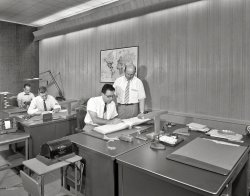
- Queens View Market: 1948
- ... photo was taken, not too far from here (24-20 32nd Street, Astoria, Queens).
There were many shopping areas frequented by my mom and ... closer to home: Ditmars Blvd, Steinway Street, and Astoria Blvd. They all had small neighborhood shops very much like this one. I ... Posted by Dave - 02/14/2015 - 9:05pm -
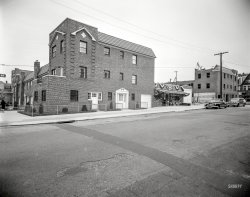
- Machine Shop: 1953
- Nov. 17, 1953. "F&R Machine Works, 44-14 Astoria Blvd., Long Island City, N.Y. General view from balcony. C.M. Johnson, ... to tiles Built in 1938, the building at 44-14 Astoria Boulevard has housed a tile company since 1980. F&R Machine Works ... Posted by Dave - 08/17/2014 - 12:14pm -
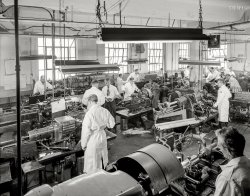
- Paramount Winners: 1925
- ... opened for its first class of students that month in Astoria, New York. The first class of students was Josephine Dunn, Robert ... Posted by Dave - 08/31/2012 - 8:18pm -
![Paramount Winners: 1925 May 25, 1925. Washington, D.C. "Winners, Paramount Motion Picture School." View full size. National Photo Company Collection glass negative.
Pretty Racy for 1925Wow, the woman on the far left leaves very little to the imagination with that shirt. I'm surprised she could walk around in public like that at that time never mind pose for photos.
NSFW: The 1925 EditionThis picture has been carefully reviewed and found to be not safe for the 1925 workplace! Seriously, keep those jazz-babies coming!
20's sensibilitiesI'm very surprised to see the girl on the left not wearing a bra and such a tight top.
Considering the sensibilities of the 1920's I thought her showing so much of her shape was socially unacceptable!
[Might be a good time to read up on the Roaring Twenties and the Jazz Age. F. Scott Fitzgerald, anyone? - Dave]
Fashion?What in the world is the woman on the right wearing? Is she sporting some fashion trend of the time, or did she forget her skirt? That seems to be an awfully racy outfit for 1925.
[1925 was an awfully racy year! - Dave]
Paramount WinnersWhat a shockingly fast crowd!
[I wonder if they need directions to the Krazy Kat. - Dave]
Bernice, is that you?The only thing that surprises me here is that the girl on the left has not yet bobbed her hair. What a fun and exciting time to be a woman -- too bad they didn't know what was coming.
1925 WAS a racy yearTangential: My father was in high school from 1923 to 1927. Once, in telling me a story about some high school escapades, he mentioned that he and his friends used to frequent a speakeasy in Calumet City called "The Speedway."
"You went to a bar?!? In high school? They let you in?"
"It was illegal for anyone to go to a bar in the 20s. They let everyone in."
Paramount Motion Picture SchoolAccording to an article in the July 21, 1925 New York Times, the Paramount Pictures School opened for its first class of students that month in Astoria, New York. The first class of students was Josephine Dunn, Robert Andrews, Greg Blackton, Charles Brokaw, Claud Buchanan, Walter J. Gross, John Luden, Ethelda Kenvin, Mona Palma, Lorraine Eason, Wilbur Dillon, Laverne Lindsay, Irving Hartley, Marian Ivy Harris, Harriet Krauth, Dorothy Nourse, Thelma Todd, and Charles E. Rogers.
The course lasted one year and those showing promise were to be offered contracts with Paramount Studios. The students appeared in the 1925 movie “Fascinating Youth.”
I’ve heard of Thelma Todd and Josephine Dunn; don’t know if any of the others made it big.
An earlier NY Times article says that the applications were done by district so these are probably the winners who applied at the Washington DC area.
I love old movies...Walter Goss (not Gross) is better known as Roland Drew. Charles Brokaw was successful on Broadway. John (Jack) Luden is more infamous than famous - you can check out his IMDB bio. Thelda Kenvin was a beauty queen. I think it should be Lindsay La Verne (aka Sharon Lynn/e). Charles Rogers is better known as BUDDY Rogers! Thelma Todd died under mysterious circumstances - that was one of the first real Hollywood scandals.
Some namesCharles E. Rogers is probably better known as Buddy Rogers. He appeared in the movie "Wings" which won the first Academy Award for Best Picture (and was the only silent to win what would become known as the Oscar in that category). He later married Mary Pickford in 1937 and was married to her until her death in 1979.
Charles Brokaw was primarily a stage actor. There's an 11 year gap between his appearance in "Fascinating Youth" and his next movie role.
Walter Gross (or Goss as IMDB has it) changed his name to Roland Drew. He had quite an active career until about 1945 although most of the movies he was in were either not memorable or minor parts for him. He's probably best known for playing Prince Barin in "Flash Gordon Conquers The Universe".
John "Jack" Luden is described by IMDB as having one of the saddest stories in Hollywood. The child of a wealthy family (they made cough drops) he got some good early roles but by about 1929 he was seriously addicted to heroin. He made something of a comeback in the '30s doing westerns at Columbia but even that ended. He was eventually arrested and convicted for dealing heroin and writing bad checks and died in San Quentin at age 49.
In the case of Thelma Todd, while she was a talented comedienne (she's great with the Marx Brothers in "Monkey Business" and "Horsefeathers", and her shorts with Zasu Pitts and Patsy Kelly are sometimes seen on TCM and are great) it was the manner of her death - carbon monoxide poisoning - that was the source of most of her enduring fame. Suicide? Accident? Murder? No one really knows for sure.
It's not the FiftiesI'm surprised at the surprise regarding "mores" of the Roaring Twenties, the Jazz Age, the Lost Generation, the era of speakeasies, fast cars, loose morals, flappers, a stock market that just went higher and higher based on nothing in particular ... sounds a lot like these days. I think when people think of a straitlaced past they're thinking of the Fifties. Which was pretty much an anomalously straitlaced decade in a very tumultuous century.
That said, what IS she wearing?
Bars and raciness@DTNelson -- we went to bars in high school all the time, and that was in the '70s. There was one place where we thought the unofficial motto was "Be 14 -- and prove it!" In the days before they raised the drinking age and finally cracked down on DWI, it was not uncommon at all.
And although that looks like some sort of wool bathing get-up, just take a look at the silk shifts many young women wore then -- cut low, hemmed high, stockings rolled (the equivalent of letting stocking tops show today). It was a party time.
History LessonThis discussion is what I meant about Shorpy being a a teaching tool specializing in photography and American history. It's fun. Thanks again, Dave and Ken.
(The Gallery, D.C., Movies, Natl Photo)](https://www.shorpy.com/files/images/13652u.thumbnail.jpg)
- The Mortgage Room: 1953
- ... at 180 West Main Street, Babylon Village. Now a branch of Astoria Federal Savings. There is a great mural of a map of Long Island behind ... on down to see if the interior of the bank (now called Astoria Federal Savings after a couple of mergers) is at all recognizable. ... Posted by Dave - 02/19/2013 - 10:08am -
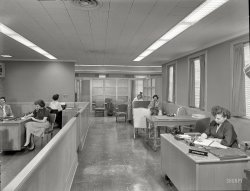
- Park Avenue: 1957
- ... the Seagram Building, the tall profile of the Waldorf-Astoria, still New York City's most quietly elegant big hotel. And right ... buildings have been added to Park since 1957. The Waldorf=Astoria still reigns on Park as the monarch of New York City hotels and can ... Posted by Dave - 09/05/2012 - 7:06pm -
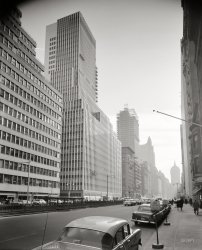
- Yerkes Mansion: 1908
- ... in 1905, he was residing in an apartment at the Waldorf Astoria Hotel, and not in the mansion seen here, which was occupied by his ... Posted by Dave - 06/06/2011 - 3:25am -
![Yerkes Mansion: 1908 New York circa 1908. "Charles T. Yerkes house, Fifth Avenue and East 68th." 8x10 glass negative, George Grantham Bain Collection. View full size.
Creator of the Chicago Loop Charles Tyson Yerkes, as the robber-baron-in-chief of Chicago traction, acquired a distinctly unsavory reputation in the Windy City and was eventually run out of town. But he created - by hook AND by by crook - one of Chicago's greatest assets: the elevated railroad loop that encircles the downtown business district, which was completed in 1897. The name "Loop" derives from the turn-around circuits of the cable car lines built in Chicago in the 1880s, but it is forever linked to the giant elevated train merry-go-round that remains a favorite with residents, tourists, and filmmakers alike.
"City Loses Yerkes Library"Financier and public transportation developer Charles T. Yerkes was one of those 19th Century capitalists whose ruthless business practices defined the term "robber baron." When he died of kidney disease in 1905, he was residing in an apartment at the Waldorf Astoria Hotel, and not in the mansion seen here, which was occupied by his wife, as reported in his New York Times obituary on December 30, 1905.
The Yerkes mansion was in the news again in 1908, when the Times reported that its attached library and art gallery, willed by Yerkes to the city for public use, was instead being lost to foreclosure.
Couldn't be more... spooky!
East 68thSomewhere along the street is an apartment building owned by a couple named Mertz.
On The AvenueIn 1895 the Yerkes Mansion was replaced by Thomas Fortune Ryan, another robber baron, who built an even larger house and garden on 2 lots. That lasted until 1950 when the architecturally ordinary 860 Fifth Avenue was built for the rich and famous.
Gone and ForgottenWhen I first saw this picture I thought "Who in the world was Charles T. Yerkes and what is he famous for?"
Well, after reading the remarks, I have decided that it is to mankind's benefit that the man has been, more or less, forgotten in just over 100 years. Too bad he didn't use some of his ill gotten gains to help people. Maybe his name would be remembered in the same spirit as Andrew Carnegie.
[He did get those rail lines built, and provided employment for thousands. As for the pejorative term "robber baron," the people who most objected to those sharp elbows were other industrialists. - Dave]
Yerkes ObservatoryI'm familiar with Yerkes in association with the observatory by that name. The U. of Chicago astronomer George Ellery Hale persuaded him to fund the observatory by pointing out that his name would be on the largest telescope in the world. Those tycoons love having their egos stroked, eh.
Dreiser booksTheodore Dreiser wrote three books "suggested" by Yerkes' life ("The Financier," "The Titan" and "The Stoic"), and they are a great read for anyone interested in that time period.
(The Gallery, G.G. Bain, NYC)](https://www.shorpy.com/files/images/01397u.thumbnail.jpg)
- Hollywood Hopefuls II: 1925
- ... school will be housed in the Paramount Eastern Studio at Astoria, Long Island." View full size. National Photo Company Collection ... Posted by Dave - 09/09/2011 - 6:22pm -
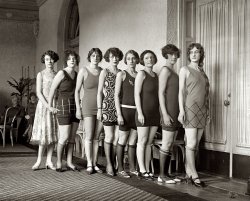
- Downtown: 1942
- ... in silhouette include the Hemsley Building, the Waldorf Astoria and the RCA Victor (later General Electric) Building.
The distant ... Posted by Dave - 05/22/2013 - 10:43am -
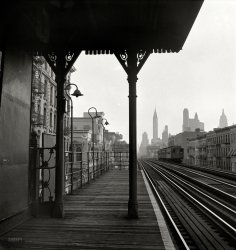
- Hell Gate: 1915
- ... it refers to a portion of the East River between Astoria, Queens and Ward Island. Between tide driven currents and rocks it was ... Posted by Dave - 10/25/2018 - 10:04am -
![Hell Gate: 1915 "Hell Gate Bridge (New York Connecting Railroad Bridge)," circa 1915. This steel arch span over the East River was completed in 1916. View full size.
I remember this bridge!I used to bike out on Ward's Island & sit next to the base of this bridge! It brings back neat memories; thank you!
The Eighth BridgeI first learned of this bridge from a memorable New Yorker article (Jan 14, 1991) written by Tom Buckley. A few extracts from the opening section are below.
Eight bridges cross the East River, Four of them - the Brooklyn Bridge, the Manhattan, the Williamsburg, and the Queensboro - have been in the news frequently in the past few years. They are the oldest, are owned by the city, and can be crossed free of charge. As a result of these interacting circumstances, they have suffered from prolonged and serious neglect, which has already cost hundreds of millions of dollars to remedy..... The three newest bridges - the Triborough, the Bronx-Whitestone, and the Throgs Neck - are by contrast, pampered darlings. They are owned by the Triborough Bridge and Tunnel Authority, and the tolls it levies are more than sufficient to keep them gleaming with fresh paint....
Whatever their condition, these seven bridges are such conspicuous landmarks that most New Yorkers could probably name at least five of them. Even a cabdriver might be able to identify two or three and drive across them without getting lost. The eighth bridge is another matter. Even in a period of heightened bridge consciousness, scarcely anyone I asked about it over a period of many months was able to provide its name or location, let alone to describe its appearance or function. ...
The Hell Gate was a lot more noticeable in 1917, when it was opened, than it seems to be nowadays. It was the longest and by far the heaviest and strongest steel-arch bridge in the world, at a time when the country rejoiced in such evidence and skill. The bridge was also the final link in one of the costliest privately financed construction projects of the industrial age - the New York Extension of the Pennsylvania Railroad. The extension brought that railroad into Manhattan, and from there to a connection with the New York, New Haven & Hartford Railroad in the Bronx, giving it, for the first time, a direct route to New England.
Hell GateThis bridge is still in regular rail use, by the way--by freight trains and Amtrak passenger rail, between NYC and Boston, Mass. I'm not ashamed to say I get a bit of a thrill when I ride across Hell Gate on the Amtrak.
View Larger Map
Hell Gate ForeverNot only is the Hell Gate bridge still in regular use, it is likely to be the longest surviving bridge of any of the current NYC spans. The February issue of Discover Magazine postulated what would happen to humans' creations if we suddenly disappeared:
Unless an earthquake strikes New York first, bridges spared yearly applications of road salt would last a few hundred years before their stays and bolts gave way (last to fall would be Hell Gate Arch, built for railroads and easily good for another thousand years).
Ok, since nobody's askedI will. Why is it called Hell Gate?
Why Hell Gate?From the Dutch "Hellegat" it refers to a portion of the East River between Astoria, Queens and Ward Island. Between tide driven currents and rocks it was extremely difficult to navigate and hundreds of ships were lost in the area. In September 1876 the worst of the rocks were blasted away by the Corps of Engineers. Navigation continues to be difficult thanks to the tidal flow (the East River isn't really a river but rather a tidal strait) but considerably easier than it was.
StackedI wonder what that smokestack is used for on the far right? It's doing something in this picture cause it's a smokin.
[It's for a coal-fired boiler. You can see the steam farther down. - Dave]
(The Gallery, Boats & Bridges, DPC, NYC)](https://www.shorpy.com/files/images/SHORPY-4a28410u.thumbnail.jpg)
- Grand Hotel: 1904
- ... the Dakota Apartments (1881-84), the former Waldorf Astoria Hotel (1893 – currently the site of the Empire State Building) and ... Posted by Dave - 04/20/2014 - 12:24am -
![Grand Hotel: 1904 New York circa 1904. "Hotel Manhattan, Madison Avenue and 42nd Street." 8x10 inch dry plate glass negative, Detroit Publishing Company. View full size.
People come, People go, Nothing ever happensThe Grand Hotel in Berlin 1932 had Greta Garbo, John Barrymore, Lionel Barrymore, Joan Crawford, Lewis Stone, Wallace Beery, and many other talented folks.
I'm sure New York had their share of famous folks too.
Trolley CarI assume the car got its power from what looks like a third rail between the tracks. Wasn't that kind of dangerous, seeing how it's street level for anyone to step on?
[New York had many cable car lines at the time. And trolleys using street-level electrical power accessed the underground line through a slot in the pavement, not via a third rail. - tterrace]
From beautiful to blandThe Manhattan Hotel was constructed in 1897, designed by architect Henry J. Hardenbergh. Hardenbergh was also the architect for the Carnegie Hall tower additions (1894), the Dakota Apartments (1881-84), the former Waldorf Astoria Hotel (1893 – currently the site of the Empire State Building) and the Plaza Hotel (1909).
The Manhattan Hotel was demolished in the 1960s for the current Sperry & Hutchinson Building (aka 330 Madison). The new building, a forgettable glass and steel tower, was constructed in 1964. Designed by Kahn & Jacobs Architects, it is 41 stories (555 feet) tall.
I'll have to ask grannyThe front of the hotel was on seedy 42nd street, and the side on Madison Avenue from 42nd to 43rd. The photo looks as if it were taken from a building obstructing Madison Avenue. The streetcar tracks curve out of the way, too.
(The Gallery, DPC, NYC, Streetcars)](https://www.shorpy.com/files/images/SHORPY_4a17565a.thumbnail.jpg)
- The Ice Wagon: 1923
- ... carried the ice up on his back.
Even after moving to Astoria, Queens, he worked long exhausting days, and well past his 65th ... Posted by Dave - 01/22/2014 - 11:36am -
![The Ice Wagon: 1923 New Orleans circa 1923. "Upper stories of buildings with wrought iron balconies." 4x5 nitrate negative by Arnold Genthe. View full size.
Real (ICE) Men!My paternal grandfather was an iceman. Born in 1890, he lived in the "Hell's Kitchen" area of NYC at 39th Street and 11th Avenue.
He plied his trade in this same area, and believe me, the buildings were a lot higher than the ones in this photo, and most had NO elevators back then, so he carried the ice up on his back.
Even after moving to Astoria, Queens, he worked long exhausting days, and well past his 65th birthday. I remember, as a small child, that after working all day, he would bounce me on his knee, and play with me, sometimes for hours.
As I sit typing this in my soft, cushy office, I can't help thinking that I wish I had half the character and strength this man had. RIP Grandpa!
Cast not wroughtGiven the detail of the uprights and arched overheads, the railing system is most likely cast iron not forged wrought iron. By the late 1800's and into the early 1900's cast iron railings, and even whole building facades, were possible. Indeed, they took off in popularity primarily because they allowed for intricate designs that were too difficult to produce via forge work.
Looks like a little Theft.. Looks like there is a home made "tap" of the utility going on (top center wires)Some one has thrown a weighted wire over the open wire and run it along the roof top. Still a common means of getting power south of the border and other poorer parts for the world.
Wonder where?Wonder where the ice came from? I remember in the Northwestern Pennsylvania town of Stoneboro, harvesting ice from near-by Sandy Lake was a major industry. It was cut out in large blocks and stored on layers of straw in the town's ice house, to last often into the summer! I suppose they and other enterprising northern towns exported some as well.
[It would have been made locally in a commercial ice plant, the first of which opened in New Orleans in 1868. -tterrace]
Looks just the same todayExcept for the the ice wagon and above ground wires, this part of Royal St looks just the same today. View is of 1127, 1133, and 1135 Royal St photographed from the second floor balcony of the Lalaurie mansion (aka "the haunted house on Royal St").
(The Gallery, Arnold Genthe, New Orleans)](https://www.shorpy.com/files/images/SHORPY_7a02783a.thumbnail.jpg)
- Custom Royal: 1958
- ... going to see the GM Motorama in 1955 and 56 in the Waldorf Astoria Ballroom in NYC. I was 13, and totally in love with tailfins, ... Posted by Dave - 10/09/2015 - 3:19pm -
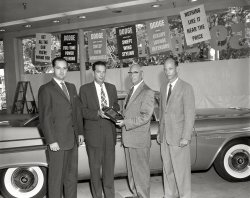
- Signal Corps Library: 1943
- ... 26 and 27. Because the SCPC was in Long Island City (at Astoria Studios), that probably matches the date range of the edition of Stars ... Posted by John.Debold - 04/30/2016 - 12:27pm -
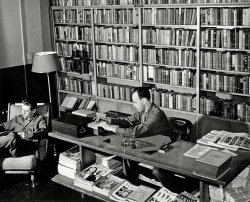
- Manhattan: 1932
- ... eventually to the "outer borough" of Queens, in areas like Astoria (where I was born).
OTY: your comments are so eloquent and ... Posted by Dave - 09/06/2014 - 10:14am -
![Manhattan: 1932 1932. "New York City views, skyline." Front-and-center is our old friend the Flatiron Building. 4x5 nitrate negative by Arnold Genthe. View full size.
MurkyThis is a surprisingly low quality image from the well-known photographer. Selecting a gloomy day, and using what we used to refer to as the bottom of a milk bottle for a lens, it is a wonder this shot was actually saved.
Grainy4x5 negative! I'd have guessed a slow 35mm film pushed to 3200 with underdiluted D76.
[A lot of that is because haze and because Photoshop. Also because film -- generally speaking, Genthe's work on glass negatives is much smoother looking. Unadjusted image below. Click to enlarge. - Dave]
Union Square constructionThe big construction site on the left of the picture is Union Square Park, which although almost 100 years old at the time of the photo had been torn up in 1928 to build the subway concourses that are still underneath it. Reconstruction was complete by 1934.
The mounted statue of George Washington by Henry Kirke Brown, which dates back to 1856, is visible near the far end of the park.
If buildings could talkI would ask them to show me exactly where my ancestors disembarked from their ships onto American soil for the first time, I would request a look at my great Uncle's "free lunch with beer" bar where my mom was a kitchen helper and that one fateful day she served a sandwich to the 20 yr. old (construction worker) man she would marry that same year (1932). I'd attend the church where they tied the knot, just the two of them and a priest. I'd want to see the exact third floor walk-up flat on the lower east side that was their first dwelling, the streets and stores they shopped in, the hospital where my older siblings were born and the beaches at Coney Island and other amusement parks where they spent long, fun-filled summer Sundays. I'd have them show me the 1939 World's Fair buildings where my Uncle John was on police duty walking the beat every day and yes, even the avenue where my seven-year old cousin Stephen was tragically killed by a speeding car. I'm sure there are a million other stories for a million other people who would like to see the actual locations where their loved ones might have had various New York experiences in which these buildings played a part. I've never had the privilege of actually residing in NYC. As the family grew, my parents moved out to a small town in Conn. where I was born and even though I always wanted to be a "New Yorker", I never actually was. I'm pretty certain though that their ten yrs. in N.Y. were really the happiest and most exciting time in their lives. The fog hanging over the city seems to represent the Great Depression since they were in the throes of it at this time but even though my parents had no money and lots of kids, it was their time to be young and they were always optimistic there. With a skyline like that and those thousands of wonderful buildings, where one can get anything from anywhere in the world, hope springs eternal.
AtmosphericThat air over lower Manhattan looks like it would really stick to your ribs!
Home, Sweet Home!My dad was born in 1919 on 39th Street and 11th Avenue (then, as now, called "Hell's Kitchen") in this wonderful city.
My grandparents (all four of them) came through Ellis Island, and settled first in Manhattan, then eventually to the "outer borough" of Queens, in areas like Astoria (where I was born).
OTY: your comments are so eloquent and nostalgic! You captured the essence of the photo and the era completely! Excellent piece of writing.
New viewMore than likely a shot from the newly constructed Empire State Building (1931). Cool picture!
(The Gallery, Arnold Genthe, NYC)](https://www.shorpy.com/files/images/SHORPY-7a01926a.thumbnail.jpg)
- Radio City: 1939
- ... Where this was taken from? I'm guessing the Waldorf Astoria?
(The Gallery, Irving Underhill, NYC) ... Posted by Dave - 10/31/2015 - 4:21pm -
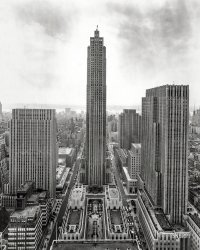
- War Wedding
- ... Callan and Catherine Geraghty. Most Precious Blood Parish, Astoria, Queens. The Norman Rockwell looking kid is Bobby Walsh, nephew of the ... Posted by Toyofield - 03/04/2008 - 10:42pm -
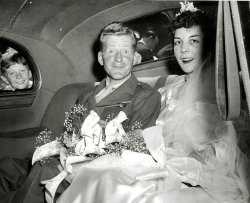
- Father of the Bride
- ... Geraghty, up the aisle at Most Precious Blood Parish in Astoria, Queens, in June 1944 for her wedding to Francis Callan. Although ... Posted by Toyofield - 03/04/2008 - 10:46pm -
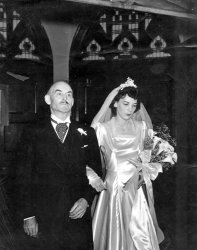
- Burr McIntosh artist print, 1902
- ... was shot when Burr had his studio across from the Waldorf Astoria in New York. I don't know who the woman is. I assume she is an actress ... Posted by toddit32 - 05/17/2009 - 10:20am -
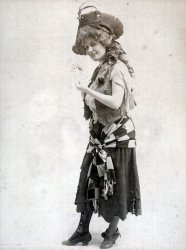
- Big Chiefs: 1911
- "The Big Chiefs -- Nez-Perce and Yakima Indians -- Astoria, Oregon, Centennial -- 1911." Panoramic photo by M.B. Marcell of ... Posted by Dave - 10/27/2019 - 4:06pm -
























